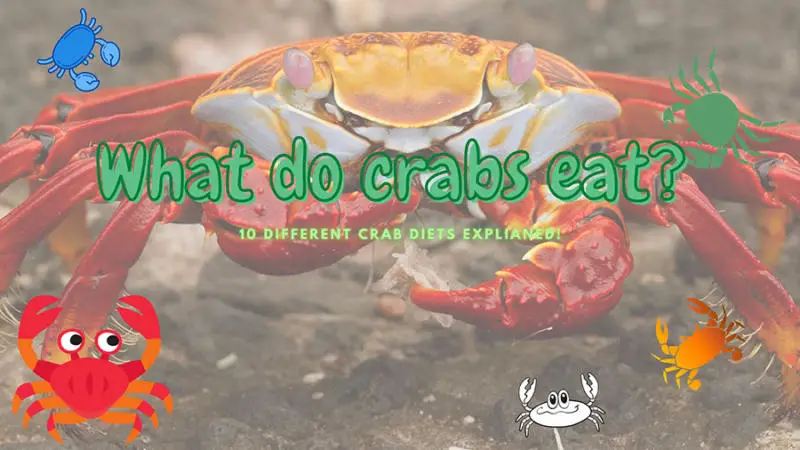In the wild, crabs form an important part of the food web since they eat a wide variety of food items and provide a nutritious meal to many.
Crabs are omnivorous crustaceans that feed on particles, animals and plants found at the bottom of the ocean or in lakes. Marine crabs like the snow crab mostly eat other animals of the sea like shrimp, clams, starfish worms and snails. Freshwater crabs tend to live on smaller animals and plants by filtering the water.
The most common food items included in the natural crab diet are:
- Shellfish like mussels, clams, crayfish and snails
- Shrimp
- (other) Crabs/crustaceans
- Plankton
- Algae/seaweed
- Plants
- worms
- Larvae
- Carrion (dead animals)
- Decaying plant and animal matter (debris)
Despite food items often being similar between different crab species, feeding strategies and behaviors differ substantially.
Some crabs prefer sifting through sand particles or filtering the water while others are active predators.
There are also differences in what time of the day different crabs eat.
Some are more active during the day, while others forage only at night. If you’re interested in learning more about the day/night rhythm of crabs, check out my post on how and when crabs sleep here.
Commercially, crabs are important in the sea-food market. While many commercial crab species are caught in the wild, other crabs (such as mud crabs and blue crabs) are bred in captivity. Additionally, they are often kept in captivity for research purposes or as pets.
Crabs kept in captivity are usually fed a consistent diet of only one or two food types, while wild crabs eat a wide variety of food. Crabs in captivity are often fed formulated foods, squid, mussels, fish, worms, brine shrimp, rotifers, and fresh fruit and vegetables.
Crabs are opportunistic feeders that will eat anything they can get. However, their diet depends largely on food availability.
Crab diets can change between seasons, as different food types become more abundant, or as they grow bigger and can handle larger food items. Cannibalism occurs in many crab species, either opportunistically, by feeding on dead crabs, or actively, by larger crabs killing and eating smaller crabs.
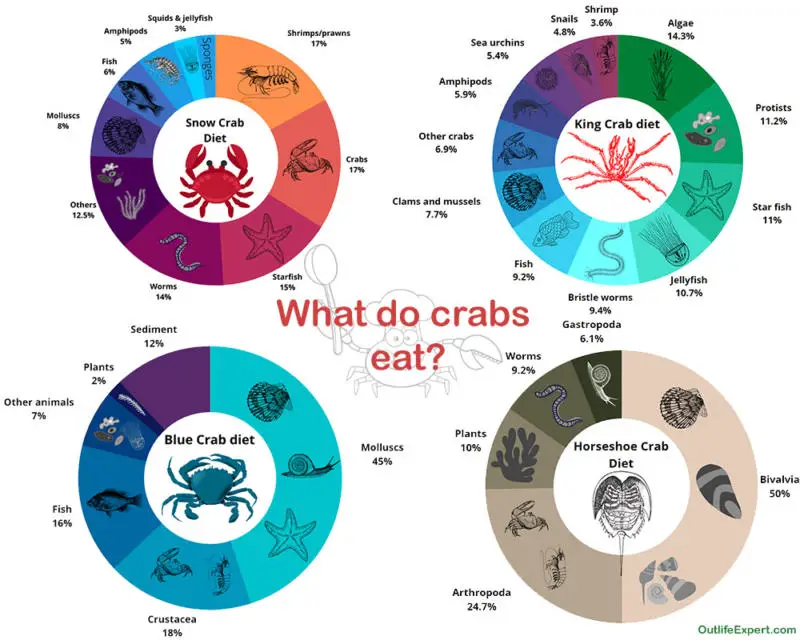
Contents
What do crabs eat in the wild?
Sea crabs eat shellfish, barnacles, shrimp, crabs, sea stars, worms, seaweed, plant matter, debris, and plankton.
While we often think of crabs as marine creatures, there are also many freshwater crab species found in tropical and subtropical areas.
Like most crabs that live in the sea, freshwater crabs eat both plant and animal matter but, obviously, there are different food sources in freshwater than in seawater.
Many of their food sources, like shellfish, worms, plant matter and debris, are similar to those of marine crabs. Freshwater crabs also eat insect larvae, small reptiles, frogs, frog eggs and tadpoles.3
A crab’s diet largely depends on its size. Big crabs can handle larger prey items and crack open hard shells.
They also need more calcium and other nutrients to maintain their larger shells. Therefore, big crabs often prefer more nutrient-rich foods, like snails, crabs, sea stars, sea worms, and fish, while small crabs prefer smaller and soft-bodied food items.
Big crabs eat a larger variety of food than small crabs. Small crabs generally eat more plant-based foods, as well as microalgae, plankton, brittle stars, and shrimp.
What do hermit crabs eat?
Hermit crabs have a fragile shell and therefore use the empty shells of other creatures to protect them. Like most crabs, they have ten legs but only six are visible.
They use the other legs to hold on to their shell. In most hermit crabs, one pincer is larger than the other. They use the large pincer to handle and break open large food items, while the smaller pincer is used like tweezers to pick up small items.1, 2
What do saltwater hermit crabs eat?
Saltwater hermit crabs mostly feed on decaying plant and animal matter.
They will use their pincers to scrape debris from rocks, or to scoop up sand to their mouth, where they carefully pick out food particles.
Their bushy antennae catch small food particles, like plankton and debris, which they remove with their mouth.
They will also browse on plants, seaweed, sponges, and sea squirts by plucking them with their pincers. Hermit crabs can also scavenge on carrion and some larger crabs will actively hunt for snails and other creatures.
What do baby crabs eat?
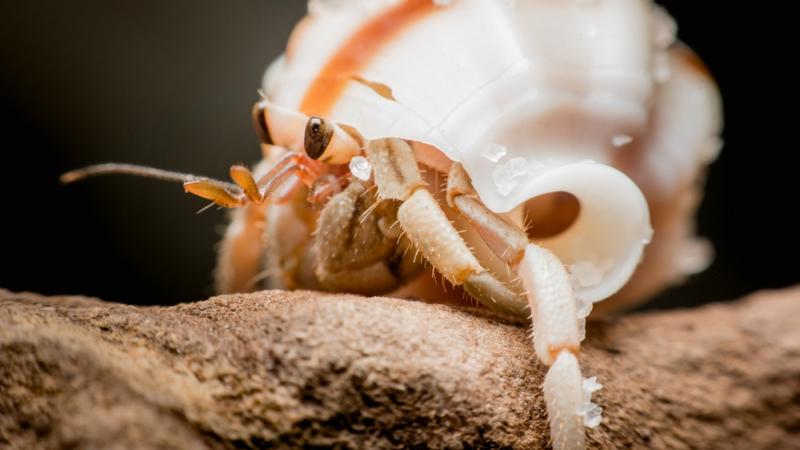
Baby crabs, like most smaller crab species, mostly eat particles floating around in the water or fish carcasses as they have a hard time hunting living prey.
All crabs start out their life as planktonic larvae. They go through several life stages before they become recognizable as crabs.
The small crabs (little crab larvae) are not large enough to prey on animals like their parents but will eat microscopic particles in the water like plankton, algae, and small worms. When they grow a bit bigger, they can start to hunt scavenge for
Even then, they need to go through several molts before they reach adult size. The small size of immature crabs comes with limitations to their menu.
This is true for most crabs, but particularly for the hermit crab is a particularly small type of crab, most of which never grows bigger than a golf ball in size. Hermit crabs eat more like the babies of larger crabs.
While adult hermit crabs eat a wider variety of food, juvenile hermit crabs are limited to smaller food particles such as debris, plankton, and microalgae.
Do big hermit crabs eat little ones?
It is quite normal for crabs to eat baby crabs of other, and even their own, species!
While cannibalism among crabs is generally common, cannibalism between hermit crabs seems to be rare in the wild, and colonies of different-sized crabs live together.
In captivity, however, larger crabs will sometimes injure or kill smaller crabs, especially when food, empty shells, or space is limited. This is also the case for most crayfish held in captivity.
While crabs often attack each other in the wild, it does not necessarily mean that they will eat each other. Although they may lose a limb or two (which can grow back eventually!), they often escape before the bigger crab gets the upper hand.
If molting crabs cannot find sufficient shelter in their enclosure while they are vulnerable, they will be easy pickings for larger crabs.
What do Blue Crabs eat?
Blue crabs have a diamond-shaped shell with a long spike extending to either side. They can be blueish grey to brownish green. Blue crabs like to eat other smaller crabs like the ghost crabs, but also marsh turtles and some species of marine snails. They also catch smaller marine crustaceans such as shrimp, barnacles, and even small lobsters.9-11
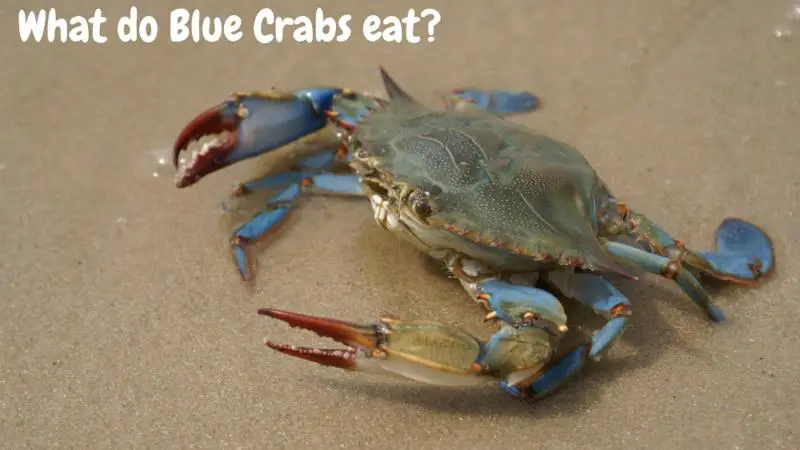
Important food items that blue crabs eat include:
They will also eat barnacles, insects, plankton, sea worms, and carrion when the need arises.
Females have orange and purple tips on their claws. They can be found in estuaries and lagoons and can tolerate both fresh- and saltwater conditions, but larvae need saltwater to grow.
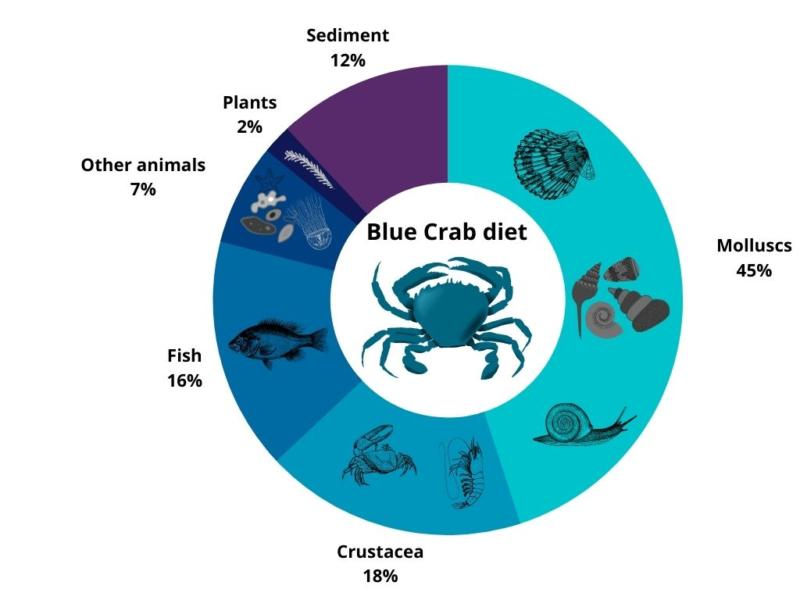
The percentage of blue crabs with each food group in their stomachs. Data from Jewett et al. 1982.
They are mainly active during the day and forage in shallow waters. They are active foragers that can move large distances. They probe the sand with their legs to find snails and clams burrowed in the sand.
Their ability to endure both saltwater and freshwater gives them a wider variety of habitats to forage in with a wider variety of food items compared to crabs that can only forage in either fresh or saltwater.
What do horseshoe crabs eat?
The horseshoe crab diet is made up of organisms that live in the soil or can be found on the soil surface.
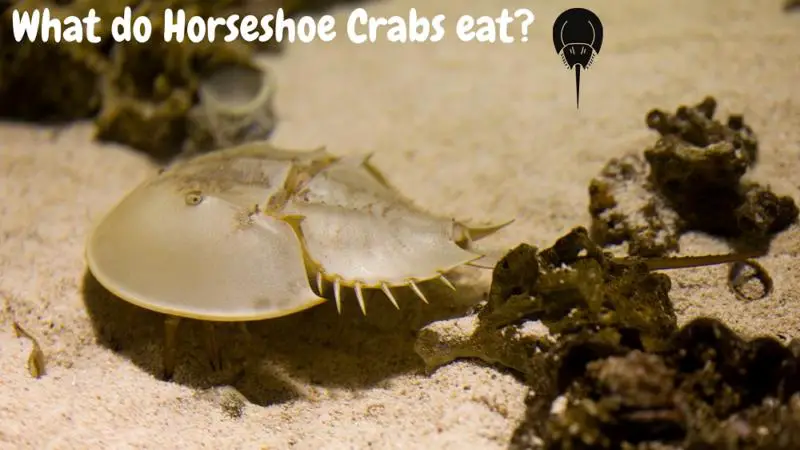
Their mouth is jawless and toothless and located between their legs. Sharp bristles on the insides of their legs grind food items before it enters their mouth.
Common food items of the horseshoe crab include:
- Clams
- snails
- sea worms
- plankton
- Other crabs and shellfish
They will also eat small fish, plant material and seaweed.
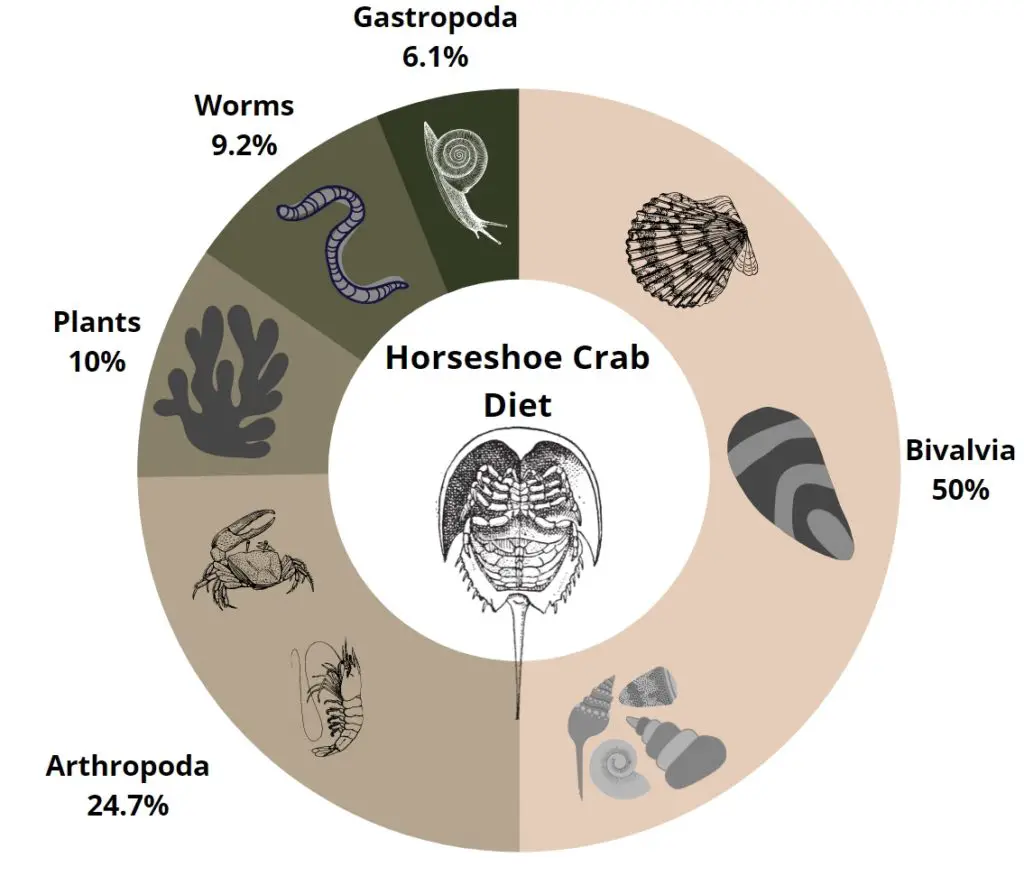
However, it is worth noticing that horseshoe crabs are not true crabs, but rather the last remaining species from an ancient group of creatures that have been around since before the dinosaurs.
Unlike true crabs, they have a long tail, twelve legs (instead of ten), and they lack antennae. They live offshore, buried under the soil, coming to shore periodically to lay their eggs.4-7
They use their shovel-shaped shell and their legs to burrow into the soil, both for refuge and to forage. Each of their legs have a set of pincers, which they use to grab food items, crush shells, and bring food to their mouth.
Their ability to dig into the soil gives them the ability to forage on buried animals, while there are many other crab species that feed on similar food items, they usually need to find them above or close to the surface.
What do Fiddler Crabs eat?
The fiddler crab can be found on beaches and in lagoons, mudflats, mangroves, and swamps.8 They prefer a mix of salt and freshwater and tolerate both to some extent but prefer brackish waters.
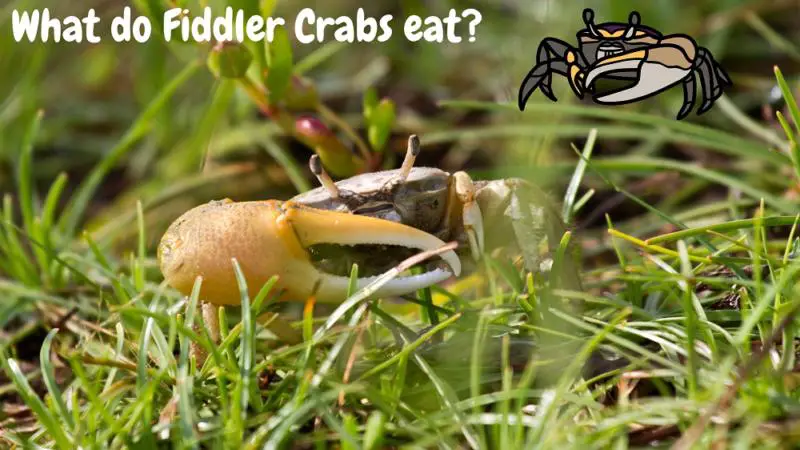
Fiddler crabs feed on sandy beaches, mostly by scooping up sand in their claws and bringing it to their mouth. They sort through the sand for food particles with their mouthparts, leaving behind small balls of sand.
Common food items of fiddler crabs include:
They are opportunistic feeders and will eat carrion and, occasionally, predate on small crabs and mussels.
Smaller claws are used for feeding and larger claws for fighting other males. They live in burrows in the sand on the beach.
In contrast to most other crabs, these crabs feed on land, instead of in the water. While they are adapted to spending time outside the water, they still need to wet their gills regularly to keep them moist and functional.
Beaches offer a unique transition between marine and terrestrial habitats and thus carrion and debris found on the beach could include elements from both habitats.
What do ghost crabs eat?
Ghost crabs are found on beaches, where they live in burrows. They are mostly active at night. Most ghost crabs have a pale color to blend in with their surroundings.
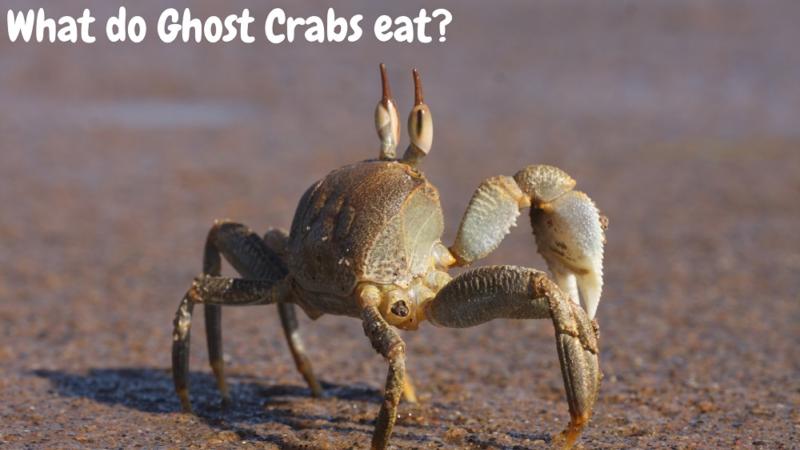
Ghost crabs are active scavengers and hunters on the beach. As opportunistic feeders, they will eat anything they can find, but they seem to prefer animal-based over plant-based food sources.12-14
Ghost crabs eat a wide range of food, including:
- Clams
- Crabs (including other ghost crabs)
- Seaweed
- Dune and sea plants
- Insects
- Carrion
- Shrimp
- Barnacles
- Algae
They will also eat plankton, marine worms, snails, debris, and larger prey, like sea turtle eggs and hatchlings, small lizards, and chicks of sea birds.
They have a box-shaped body and one claw that is bigger than the other, but not as big as in male fiddler crabs. Their long eye stalks give them a distinctive look.
Like the fiddler crabs, ghost crabs also forage on land. However, they forage at night, and they are active foragers and predators, in contrast to the fiddler crabs who mostly sift through sand for food particles.
However, when ghost crabs do participate in deposit feeding (filtration of sand) they can extract as much as 70% of the algae content of the sediment they ingest.
What do king crabs eat?
King crabs are the largest commercially important crab. They can grow up to 11 inches in body width and weigh 24 pounds.
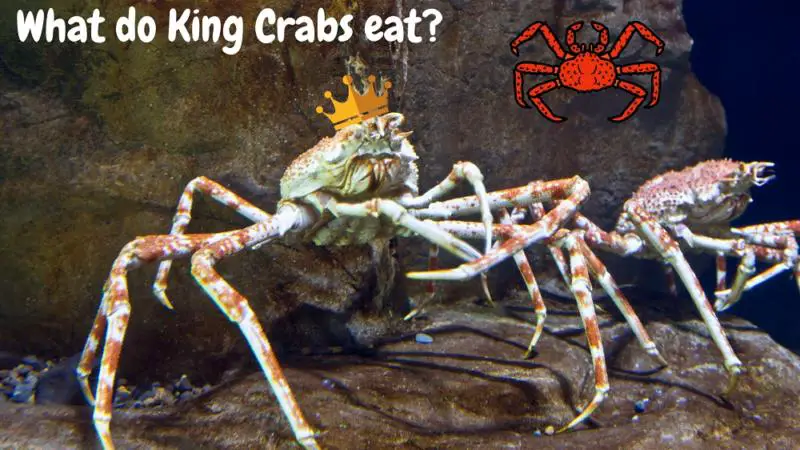
Their diet differs based on their location and on the presence of other competing predators in the area, showing that they are opportunistic feeders.15
The most important prey items of king crabs are:
- clams
- mussels
- cockles
- barnacles
- snails
- sea stars
- brittle stars
- sea urchins
- other crabs
- shrimp
- sea worms
- Algae and protists
King crabs are found in the polar regions of the world in shallow waters with rocks, boulders, or cobbles. They have eight legs, instead of ten, and are covered in sharp spines.
King crabs are large, fast-moving predators that will actively seek out their prey, either in groups or alone.
Even though they eat other crabs, cannibalism is rare in nature.
They will also eat plankton, microalgae, seaweed, fish, sponges, seagrass, and squid. When larger food items are scarce, they will scoop up sand to feed on smaller food items.
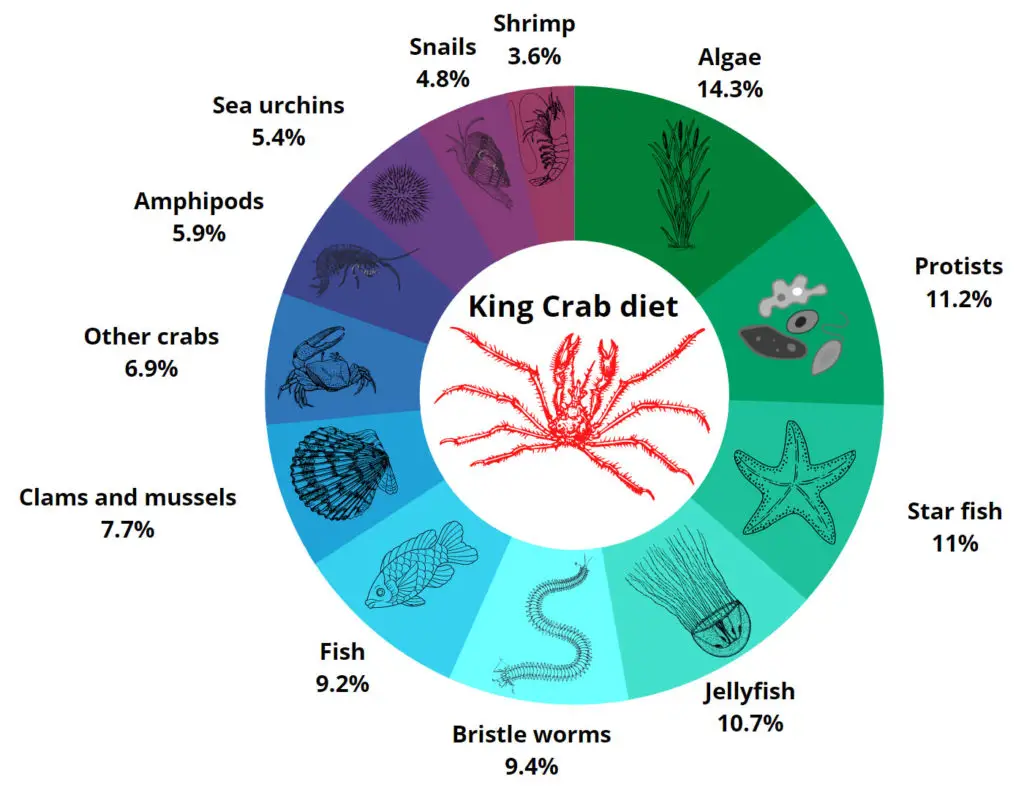
The percentages represent how often (not how much) king crabs in various studies had the food item in their gut. These food items represent the overall crab diet quite well.
Being one of the largest crab species, they consume larger prey items, compared to smaller crab species.
Their tendency to live and feed in large groups gives them the ability to take down large prey items such as large starfish.
What do snow crabs eat?
The snow crab is found in the polar regions, even further north than the king crab, preferring deep waters. They are bright red to brown with a round body and long legs.
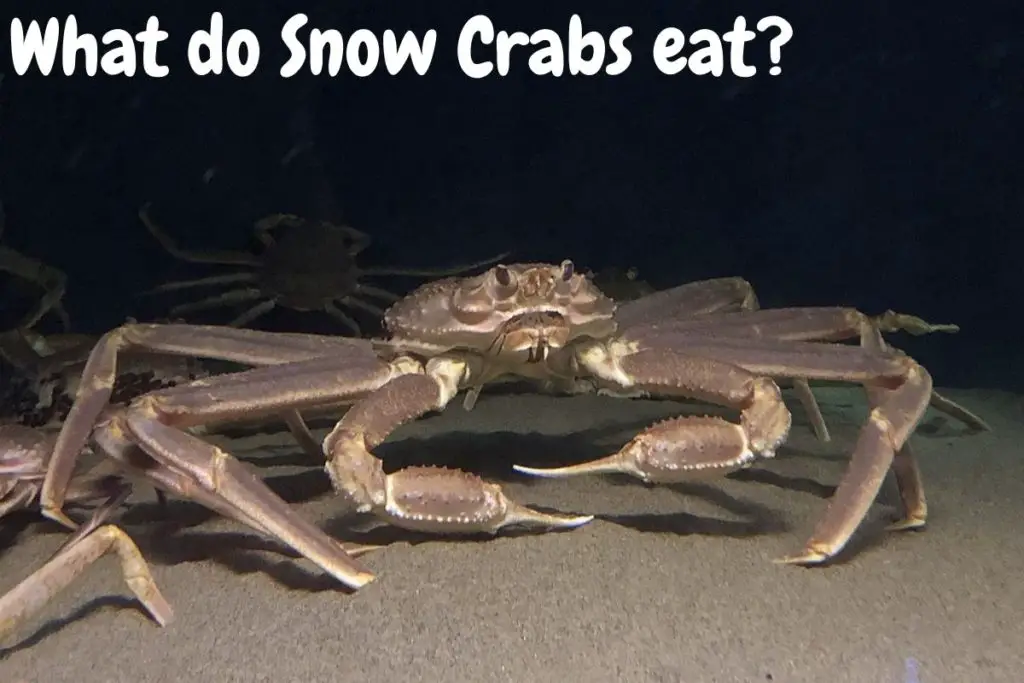
Adult males can reach 2 to 6.5 inches in body width and females 1.5 to 4 inches.
Snow crabs are slow-moving predators, preying mostly on sedentary animals and plant matter.16-18
They will either catch their prey with their claws or scoop up sediment to their mouth and pick out food particles. Important food items include:
- Fish
- Shrimp
- Other crabs
- Clams
- Sponges
- Brittle stars
- Sea worms
- Starfish
- Amphipods
- Jellyfish
- Snails
- Seaweed
They also eat plankton and debris. Cannibalism is common in snow crabs and is believed to shape the age structure of populations and the distribution patterns of individuals.
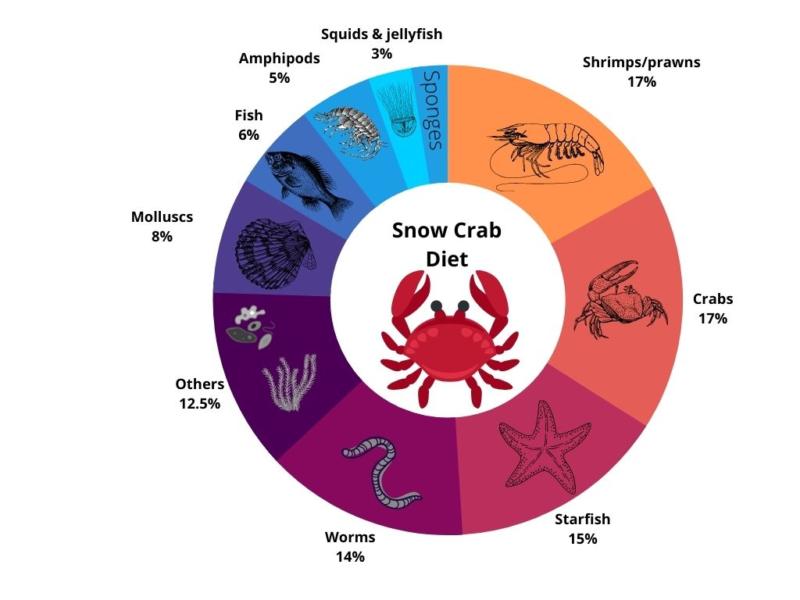
Different-sized snow crabs are found at different depths, possibly so that smaller crabs can avoid cannibalism by bigger crabs.
Even though they are large, active predators, like the king crabs, they are slow-moving and mostly rely on sedentary prey.
What do green crabs eat?
Green crabs can be found in marine and estuarine habitats, including mud, sand and rocky areas in shallow waters.
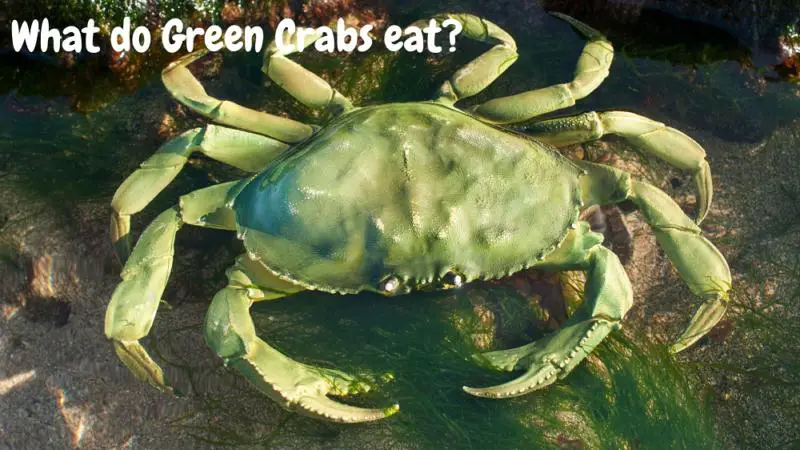
In rocky areas, green crabs also eat sea snails. They also feed on the seagrass and seaweed that they hide between.
Like the blue crab, they are active predators that hunt in shallow waters, but, unlike blue crabs, they cannot forage in fresh water.10
Important food items in the diet of the green crab include:
- Mussels
- Clams
- Snails
- Shrimp
- Crabs (including their own species)
- Sea worms
- fish
- Carrion
- Plankton
With their dark, mottled brown to green color they can easily blend in between aquatic vegetation or seaweed.
There is also a red color morph of the green crab that blends in better in deeper waters, where red light does not penetrate, and the crabs appear brown. Adult green crabs can reach 2 to 4 inches in body width.
What do mud crabs eat?
As the name suggests, mud crabs live in the mud of estuaries and mangroves.
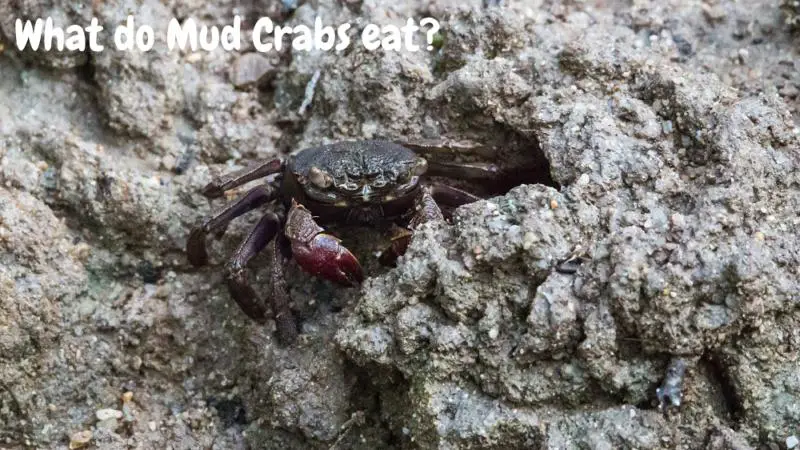
Mud crabs forage at night. They will eat anything they can find, especially stationary or slow-moving creatures and plant materials.10
The most common food items of mud crabs include:
- Mussels
- Snails
- Crabs
- Worms
- Dead fish
- Animal carcuses
- Slugs
They will also eat fish, plant material, debris, and carrion.
Some of them live in burrows. Depending on the species and location, mud crabs can be brown or black with hues of red, green or yellow. Adults can reach 6 to 11 inches in body width and weigh 3.5 to 6.5 pounds.
Living in estuaries and mangroves mean that they have different food types available than would be available in a marine environment. Like the ghost crabs, they are night-time foragers, therefore they can avoid competition with day-time foragers and feed on prey items that are active at night.
What do crabs eat when on land?
While most crabs are found either in saltwater or in freshwater, some crab species, like the fiddler crab and the ghost crab mentioned above, are adapted to living on land.
These adaptations enable them to find a wider variety of food sources such as insects, reptiles, and plant material.
What do crabs eat on the beach?
On the beach, crabs can sift through sand for small food particles, feed on carrion, look for snails, worms and other creatures that burrow into the sand, or pick barnacles and mussels from rocks.
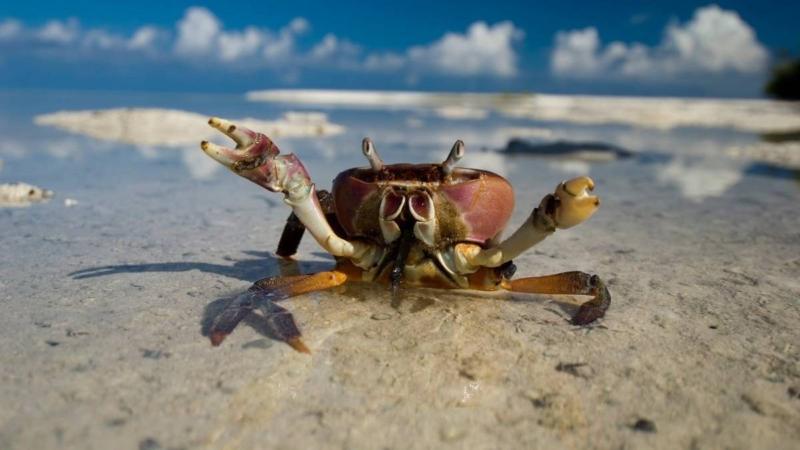
With the beach acting as an interface between land and sea, they can feed on both terrestrial and marine food sources.
For example, they can feed on both dune vegetation and kelp, insects and shellfish, and eggs of both terrestrial and marine animals.
What else do crabs eat? (Crab diet FAQs)
We have gone through the typical diets of a handful of common crabs above. However, I get many questions on specific items and whether they are included in the diets of our crustacean friends or not.
Below is a selection of common questions on food and my best efforts to answer whether crabs eat them or not. However, if you have read the article above, I am confident that you will already have a good idea of what items are included or not!
In fact, most animals that crabs can readily access, and that do not kill them, will be good sources of food for almost any crab. However, the accessibility of the food strongly depends on the type of crab hunting for the type of prey. More on this in the following!
Do crabs eat plankton?
Yes, several crabs have the ability to eat both zooplankton and phytoplankton.
Whereas zooplankton is basically microscopic animals and protists, phytoplankton consists mainly of microalgae (single-celled plants), but is often loosely defined as all microorganisms that obtain their energy from the sun, which would include cyanobacteria and Euglena species.
The prevalence of each type of plankton in their diet depends on the environment in which they live, and they usually don’t distinguish or have a preference between them.
Crabs eat plankton either by filtering the water or the sand and other sediments for microscopic particles.
Crabs that filter the water for plankton are called filter-feeders while those that filter sand or sediment are called deposit-feeders. Some of these have specialized gills that are used for feeding as well as breathing!
An example of a filter-feeding crab is the porcelain crab. They are called porcelain crabs due to their fragile nature and they tend to lose limbs. Luckily, crabs can regenerate most of their limbs again.
Porcelain crabs have specialized appendices on their arms that look like an antenna but rather than catching radio signals, they catch all sorts of planktonic microorganisms such as Euglena and algae.
This type of filter-feeding with suspended appendages is also called “suspension-feeding”.
Hermit crabs, such as the common marine hermit crab (Pagurus bernhardus), can also filter feed. Although hermit crabs lack the specialized organs of the porcelain crabs, they can use their front legs to generate a current of water into their mouth from which they eat the zoo and phyto plankton present in the water.
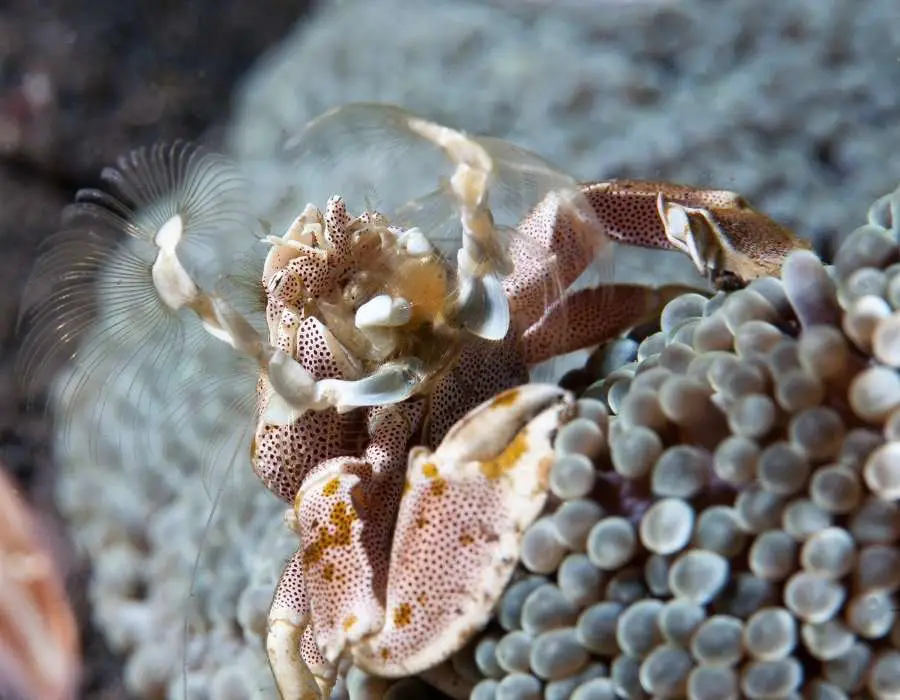
Examples of deposit-feeders are fiddler crabs, ghost crabs, Semaphore Crab, and Sand Bubbler Crabs. These crabs “ingest” the sand to filter out plankton particles, bacteria, and leftovers of dead animals, and plants.
Do crabs eat seaweed?
Yes, most crab species eat seaweed as can be seen from the stomach contents studies presented at the beginning of this article.
They will eat different types of seaweed, from giant kelps to small sea lettuce.
Crabs use their pincers to cut off pieces of seaweed or to pluck seaweed from the substrate and bring it to their mouth.
However, most crab species seem to prefer animal-based food over seaweed, since animal-based food is higher in nutrients – especially protein, which often constitutes up to 30% of a crab’s diet.
Seaweed, however, often serves as an abundant and easily accessible food source, especially during hard times when other food sources might not be available.
Do crabs eat algae?
Yes, most crabs can eat algae in one form or the other.
Crabs can eat either microscopic algae such as phytoplankton or macroscopic algae such as seaweed.
As described in the two sections above, algae is a common food source for crabs and they will either filter it from sand or water or eat macroscopic algae directly using their claws and mouthparts.
Some species do also scrape off and eat densely packed layers of sediment from rocks and other objects in the sea where algae grow along with bacteria.
Do crabs eat shrimp?
Yes they do. Because crabs are omnivorous and sometimes cannibals they do not hesitate to eat fellow crustaceans – including shrimp.
Crabs and shrimp reside together at the bottom of the sea where they both feed on decaying plant and animal matter.
And because they reside in the same niche, they will often encounter the remains of each other’s decaying bodies and crabs are not picky when it comes to dead animal matter in their diet!
However, living shrimp are relatively small and oftentimes too fast for most crabs to catch.
Do crabs eat amphipods?
Most crabs will eat dead amphipods as they are an excellent source of protein and reside in the same environment.
Amphipods are crustaceans ranging from about 0.04 inches to more than 10 inches in size. They are scavengers like crabs, and often reside in the ocean floor with crabs and other crustaceans.
While amphipods are often fast for most crabs to catch when alive, many types of fish, including Mandarin fish, Clownfish and Pipefish, are fast enough to hunt and eat smaller amphipods in aquariums.
However, smaller crab species like the hermit crabs are known to be quite proficient at catching and feeding on amphipods. Therefore, hermit crabs may also be used to get rid of unwanted amphipods in fish tanks.
Do crabs eat crayfish?
Rarely, but mostly because they are hard to catch.
While crabs and crayfish are scavengers eating mostly dead animals, they can both be aggressive if feeling threatened and both do sometimes attack other crustaceans.
There are many examples of crabs eating crayfish and vice versa. It is often the bigger of the two that initiates the aggression and wins the fight.
When crabs and crayfish fight the crab tends to win because a larger proportion of a crab’s body is covered by hard shell and the tail of the crayfish is exposed to the claws of the crabs.
However, crayfish and lobsters have a strong flexible tail that allow them to swim away from encounters fast, often saving them from being eaten by crabs.
Do crabs eat starfish?
Yes! Especially the bigger crab species like the King Crab.
While you might think that starfish are slow movers and easy prey for crabs, it is not common for most crabs to eat starfish (or sea stars) in nature.
Although a starving crab may be encouraged to attack and eat living starfish, crabs usually prefer to eat them after they have died.
Living starfish are usually consumed by larger crabs such as the Snow Crab and King Crab and starfish constitute around 15% of snow crabs diet (see section on snow crab food preferences above).
They are usually eaten to a lesser extent by King Crabs and mostly at 16-50 meter sea depths and rarely deeper than 80 meters.
But what about the other way around?
Starfish may actually be quite aggressive towards crabs and are known to attach and devour living crabs via coordinated attacks in large numbers.
For example, the North Pacific Starfish has been observed to overwhelm fairly large spider crabs and eat them during moulting season.
Do crabs eat sea urchins?
Some crabs, like the king crab, eat sea urchins, but it requires a certain strength to open their shell.
Sea urchins are challenging to eat because most of their body is covered in a hard spiky shell.
However, crabs also carry hard exoskeletons, so crabs do have the ability to withstand the spikes of sea urchins.
Furthermore, the claws of larger crabs are able to break the shell of sea urchins to access and eat their soft tissue.
A good example is the King Crab that is fairly capable of consuming sea urchins and does so almost all water depths. King Crabs are strong and can easily crush the shell of sea urchins with their pinchers.
King crabs have been documented to eat sea urchins at sea depths as deep as 300 meters.
Do crabs eat jellyfish?
Yes, but since crabs live on the bottom of the sea they do often not easily come into contact with jellyfish that swim in the open sea. However, they will be able to reach dying or stranded jellyfish and they will also eat swimming jellyfish when possible.
The early life stages of jellyfish do take place attached to the sea floor where they are easy prey for the crabs they may encounter.
Crabs may also encounter jellyfish that have died and washed up on the beach. Fiddler crabs and ghost crabs would be happy to feast on such a catch.
In these cares some crabs might be opportunistic feeders and eat the jellyfish. The stinging cells of jellyfish are unlikely to penetrate the hard shell and mouth pieces of crabs and do not bother them.
Do crabs eat fruit?
Yes, some crabs, like the coconut crab and some hermit crabs, do indeed eat fruit!
It may seem surprising, but there are many land crabs that eat fruit pulp.
Depending on the crabs size it can grab hold of and drag away large fruits such as Mangoes.
The coconut crab is gigantic (in fact the largest terrestrial crab alive!) and has evolved to be able to climb palm trees and break into coconuts to eat them.
By moving fruits that contain seeds, crabs can contribute to seed dispersal which helps plants establish in new areas.
See the video below for a brief introduction to the coconut crab:
Do crabs eat sand?
No, they do not eat the sand, but they filter it for food.
Some crabs do indeed appear to eat sand. But in fact, they are filtering the sand (so called deposit-feeding) and eating the contained algae, cyanobacteria, small invertebrates and/or tiny particles of dead animals.
Some crabs, like the mole crab, ghost crab, and fiddler crab frequently participate in filter-feeding and can extract up to 70% of plant and nutrient matter from the filtered sand.
If you buy sand or rocks for you aquarium however, I would recommend you to sanitize it for microorganisms first. The ecosystem of your aquarium will establish itself and your crabs will soon be able to feed on the algae, protists and death animal matter that accumulate in the sand.
Do crabs eat turtles?
Crabs generally leave adult turtles alone but are a big problem for small sea turtles.
Baby turtles, as cruel as it may be, are often eaten by crabs when they emerge from their nests on the beach or when they are still in their eggs.
Because crabs can run much faster on the beach than baby sea turtles, they may catch them before they can reach the sea to swim off.
The crabs eat the soft parts and leave the rest. Some crabs are known to eat the flesh of dead animals, including land- and sea turtles.
Do crabs eat anemones?
Dead anemones are easy prey for most crabs.
However, live anemones have protective stinging cells as jellyfish do. While these will not always penetrate the hard shell and mouthparts of crabs, crabs may feed on them opportunistically.
But rather than eating anemones, some crabs use them to their advantage in other ways.
Crabs like the Pom Pom crab do not eat anemones and have instead developed a symbiotic relationship with them.
This beautiful crab is very small and therefore vulnerable to being eaten by big fish.
As a defence mechanism, the Pom Pom crab constantly holds two small anemones in its claws, waving them around like a cheerleader.
The anemones are used by the crab to chase predators away by stinging them and in turn, they get the benefit of eating part of the crab’s food.
Do crabs eat squid and octopi?
If the squid is dead – yes! But a large squid or octopus is a challenge for most crabs.
The Cephalopoda is a group of marine mollusks that includes cuttlefish, squid, nautilus, and snails, is characterized by symmetrical bodies with tentacles protruding from the body.
Octopuses are soft cephalopods, which do not have an outer shell and include the giant Pacific octopus.
Many larger squid and octopuses actually love to feed on crabs! Especially the giant pacific octopus loves to attack and eat marine crabs.
Do crabs eat worms?
Yes, most crabs eat many types of marine worms especially bristle worms like sandworm, clamworm, and lugworm.
Worms, especially the marine members of the Polychaeta class of worms, are an important food source for many crabs.
However, some crabs eat more worms than others and worms.
Whereas worms are seldom found in the diet of the Blue Crab, they make up around 10% of the Snow Crab, King Crab and Horseshoe Crabs diets.
Do crabs eat insects?
Yes, but mostly those that feed on land.
Insects are more or less strictly land animals and do not live underwater where most crabs reside.
Those crabs, like the mole crab, fiddler and ghost crabs that filter through sand to find food, do however, ingest quite a substantial amount of insects.
Also, dead insects may drop to the bottom of lakes and the sea where crabs will be able reach and ingest them.
Do crabs eat flies?
Flies are not readily accessible to crabs as flies are only found on land. Dead flies however may be eaten by crabs if they fall into the water.
Flies may also be present in the sand that is filtered by deposit-feeding crabs such as the fiddler or ghost crabs.
Do crabs eat spiders?
The short answer is no.
Because spiders are insects that live strictly on land, they are unlikely to make up a substantial part of any crabs diet.
Although rare, small spiders or their eggs may be filtered from sand by filter-feeding crabs.
Do crabs eat geckos?
Because geckos are not water animals, few marine crabs would have easy access to geckos.
If land crabs are fast enough they might be able to catch a gecko, but it is unlikely as geckos are faster than crabs. Therefore it is not likely to be part of most crab diets. However, dead lizards are known to be eaten by many crabs.
However, some geckos will accidentally fall into the water and most geckos are able to swim – and some can even run on the water surface!
But because geckos swim significantly slower than they can run on land, there will be a chance that they will be caught by a hungry crab or another water predatory animal.
Do crabs eat frogs?
Crabs that live in seawater are unlikely to encounter frogs because these can only survive in freshwater.
However, the crabs that live in freshwater could catch frogs and eat them, but they need to be fast.
They are much more likely to feed on dead frogs, tadpoles or frogspawn.
Do crabs eat seagulls?
If a terrestrial crab encounters a dead seagull, then yes!
There are even examples of the large coconut crab attacking and overwhelming living sea birds on land.
What do crabs eat in a fish tank?
They will eat whatever is present such as fish food, algae, cyanobacteria and dead animals. Most crabs do a good job at cleaning out your tank.
They eat mostly the same as they would eat in the wild. All the items previously described in this post can be good options for feeding your pet crab.
Many of the food items eaten by crabs in captivity will overlap with those listed for the different crabs described previously in this article. So be carefull if you plan to keep crabs and e.g. snails or crayfish together.
However, you can also buy designated crab food items suited for crabs kept in fish tanks in your lokal pet store.
Conclusion
Crabs are diverse and fascinating creatures. Their diet is variable and adaptable, shaped by both food availability and nutrient requirements.
There is no simple answer to the question “What do crabs eat?” because crabs include vastly different species living in different environments.
However, understanding their natural diet helps us understand the nutritional needs of crabs in captivity and elucidates the vital role they play in the ecosystem.
References:
- Hazlet BA. 1981. The behavioral ecology of hermit crabs. Annual Review of Ecology, Evolution, and Systematics 12: 1-22
- Schembri PJ. 1982. Feeding behaviour of fifteen species of hermit crabs (Crustacea: Decapoda: Anomura) from the Otago region, southeastern New Zealand. Journal of Natural History 16: 859-878
- Wehrtmann IS, Hernandez-Diaz D, Cumberlidge N. 1999. Freshwater crabs as predators and prey: the case of Ptychophallus uncinatus Campos & Lemaitre, 1999 (Brachyura, Pseudothelphusidae) from Costa Rica, Central America. Latin American Journal of Aquatic Research 47 (1): 18-26. http://dx.doi.org/10.3856/vol47-issue1-fulltext-3
- Botton ML. 1984. Diet and food preferences of the adult horseshoe crab Limulus poluphemus in Delaware Bay, New Jersey, USA. Marine Biology 81: 199-207
- Carmichael RH and Brush E. 2012. Three decades of horseshoe crab rearing: a review of conditions for captive growth and survival. Review in Aquaculture 4: 23-43
- Lockwood S. 1870. The horse foot crab. The American Naturalist 4 (5): 257-274
- National Oceanic and Atmospheric Administration Office for Coastal Management worksheet on horseshoe crabs: https://coast.noaa.gov/data/estuaries/pdf/hooray-for-horseshoe-crabs-student-master-1.pdf
- Saher NU and Qureshi NA. 2014. Food and feeding ecology of fiddler crabs species found along the coast of Pakistan. Romanian Journal of Biology 59 (1): 35-46
- Rosas C, Lazaro-Chavez and Buckle-Ramirez F. 1994. Feeding habits and food niche segregation of Callinectes sapidus, C. rathbunae, and C. similis in a subtropical coastal lagoon of the Gulf of Mexico. Journal of Crustacean Biology 14 (2): 371–382. doi:10.1163/193724094×00344
- Santhanam R. 2018. Biology and culture of portunid crabs of world seas. Apple Academic Press, Ontario, Canada. 403 pp.
- Tagatz ME. 1968. Biology of the blue crab, Callinectes sapidus Rathbun, in the St. John’s River, Florida. Fishery bulletin 67 (1): 17-33
- Rae C, Hyndes GA and Schlacher TA. 2019. Trophic ecology of ghost crabs with diverse tastes: Unwilling vegetarians. Estuarine, Coastal and Shelf Science 224: 272-280. https://doi.org/10.1016/j.ecss.2019.02.023
- Wolcott TG. 1978. Ecological role of ghost crabs, Ocypode quadrata (Fabricius) on an ocean beach: Scavengers or predators? Journal of Experimental Marine Biology and Ecology 31: 67-82
- Young AYP and Lim SSL. 2019. Quantitative methods for the determination of abundance of mobile prey of ghost crabs Ocypode Weber, 1795 (Decapoda: Brachyura: Ocypodidae), a top predator on sandy shores. Journal of Crustacean Biology 39 (4): 516-521. doi:10.1093/jcbiol/ruz022
- Stevens BG. 2014. King Crabs of the World. CRC Press, Florida USA, 594 pp.
- Hansen HSB. 2015. Snow crab (Chionoecetes opilio) in the Barents Sea – Diet, biology, and management. Master thesis, Norwegian College of Fishery Science
- Wieczorek SK and Hooper RG. 1995. Relationship between diet and food availability in the snow crab Chionoecetes opilio (O. Fabricius) in Bonne Bay, Newfoundland. Journal of Crustacean Biology 15 (2): 236-247.
- Lovrich GA and Sainte-Marie B. 1997. Cannibalism in the snow crab, Chionoecetes opilio (O. Fabricius) (Brachyura: Majidae), and its potential importance to recruitment. Journal of Experimental Marine Biology and Ecology 211: 225-245. https://doi.org/10.1016/S0022-0981(96)02715-3

